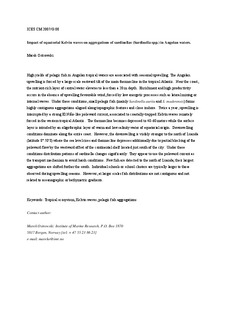| dc.contributor.author | Ostrowski, Marek | |
| dc.date.accessioned | 2012-02-07T08:45:04Z | |
| dc.date.available | 2012-02-07T08:45:04Z | |
| dc.date.issued | 2007 | |
| dc.identifier.citation | This report is not to be quoted without prior consultation with the General Secretary. | no_NO |
| dc.identifier.uri | http://hdl.handle.net/11250/103192 | |
| dc.description.abstract | High yields of pelagic fish in Angolan tropical waters are associated with seasonal upwelling. The Angolan
upwelling is forced by a large-scale eastward tilt of the main thermocline in the tropical Atlantic. Near the coast,
the nutrient-rich layer of central water elevates to less than a 20 m depth. Enrichment and high productivity
occurs in the absence of upwelling favourable wind, forced by low energetic processes such as lateral mixing or
internal waves. Under these conditions, small pelagic fish (mainly Sardinella aurita and S. maderensis) forms
highly contiguous aggregations aligned along topographic features and close inshore. Twice a year, upwelling is
interrupted by a strong El Niño-like poleward current, associated to coastally-trapped Kelvin waves remotely
forced in the western tropical Atlantic. The thermocline becomes depressed to 40-60 meters while the surface
layer is intruded by an oligothrophic layer of warm and low salinity water of equatorial origin. Downwelling
conditions dominate along the entire coast. However, the downwelling is visibly stronger to the north of Luanda
(latitude 8° 50'S) where the sea level rises and thermocline depresses additionally due to partial blocking of the
poleward flow by the westward offset of the continental shelf located just south of the city. Under these
conditions distribution patterns of sardinella changes significantly. They appear to use the poleward current as
the transport mechanism to avoid harsh conditions. Few fish are detected to the north of Luanda; their largest
aggregations are shifted further the south. Individual schools or school clusters are typically larger to those
observed during upwelling seasons. However, at larger scales fish distributions are not contiguous and not
related to oceanographic or bathymetric gradients. | no_NO |
| dc.language.iso | eng | no_NO |
| dc.publisher | ICES | no_NO |
| dc.relation.ispartofseries | ICES CM documents;2007/G:08 | |
| dc.subject | ecosystems | no_NO |
| dc.subject | økosystemer | no_NO |
| dc.subject | pelagic fish | no_NO |
| dc.subject | pelagisk fisk | no_NO |
| dc.title | Impact of equatorial Kelvin waves on aggregations of sardinellas (Sardinella spp.) in Angolan waters. | no_NO |
| dc.type | Working paper | no_NO |
| dc.subject.nsi | VDP::Agriculture and fishery disciplines: 900::Fisheries science: 920::Resource biology: 921 | no_NO |
| dc.source.pagenumber | 32 s. | no_NO |
